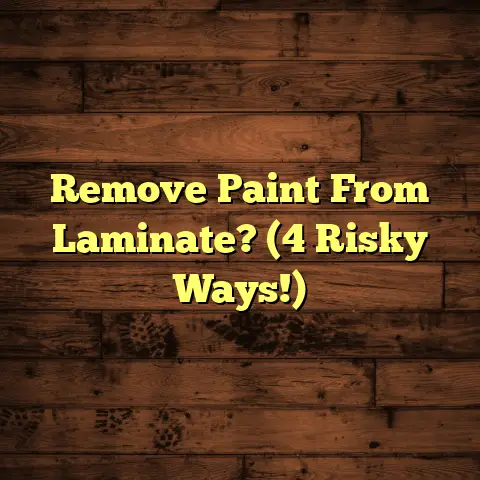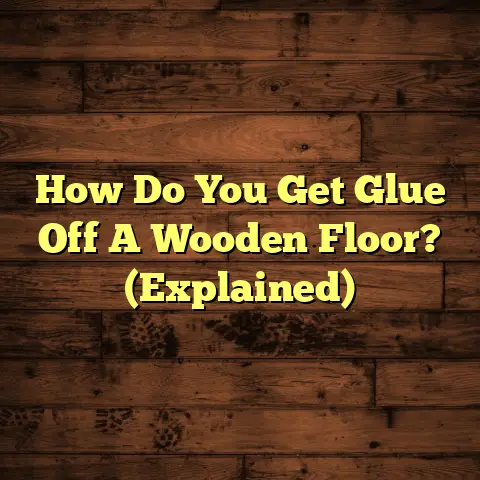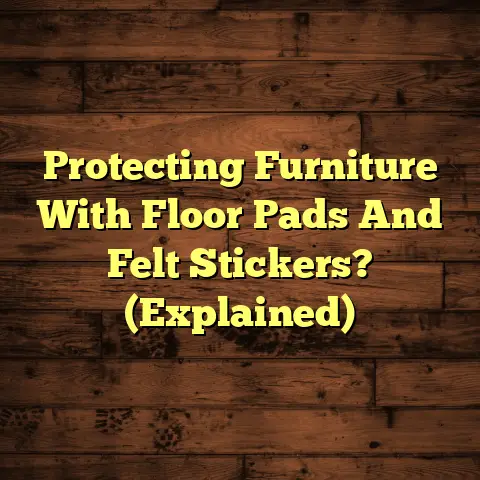How To Repair Scratched Glued Wood Flooring? (Explained)
Did you know that around 70% of homeowners encounter scratches on their wood flooring at some point? As a flooring contractor with years of experience, I’ve seen this issue firsthand in various homes. Scratches can occur for many reasons—furniture dragging, pet claws, or even just regular wear and tear.
Identifying the Type of Scratch
Before jumping into the repair process, let’s talk about identifying the type of scratch. Understanding the nature of the damage will guide you in choosing the right repair method. There are three main categories: surface scratches, deep scratches, and gouges.
- Surface Scratches: These are light marks that barely penetrate the finish. Often, they’re easy to address and can be fixed quickly with minimal effort.
- Deep Scratches: These penetrate the finish and may reach the wood itself. They require more effort and careful treatment to restore the floor’s appearance.
- Gouges: This is where you see a chunk missing from the floor, often needing a more extensive repair approach. This could happen due to heavy furniture being moved or accidents, and they can be particularly challenging.
I remember a project where a client had a deep scratch from a moving furniture mishap. They were worried it would ruin the floor’s appearance, but with the right techniques, I was able to restore it beautifully.
Tools and Materials You’ll Need
Having the right tools makes all the difference in any flooring repair project. Here’s what I usually gather for a successful repair:
- Wood Fill or Putty: For deep scratches and gouges, a quality wood fill is essential. Look for one that matches your wood type for the best results.
- Sandpaper: Various grits (120 for initial sanding, 220 for finishing) are important for smoothing out repairs.
- Wood Finish: This should match your existing flooring’s finish as closely as possible. Whether it’s oil-based or water-based, choose accordingly.
- Clean Cloths: Soft cloths are great for applying and wiping away excess materials without scratching the surface.
- Putty Knife: To apply wood fill or putty smoothly, a putty knife is necessary.
- Vacuum or Broom: Keeping your work area clean helps avoid introducing dirt into the repair process.
- Protective Gear: Don’t forget gloves and a mask if you’re working with strong chemicals or dust.
I always recommend investing in quality materials. For instance, using a high-quality wood fill can make your repair last longer and blend seamlessly with the existing floor.
Step-by-Step Repair Process
Now, let’s break down how I tackle these scratches in detail.
Repairing Surface Scratches
- Clean the Area: Start by cleaning the scratched area with a damp cloth. Any dirt or debris can create more scratches during repair. I often use a gentle soap solution for this step to ensure thorough cleaning.
- Apply Wood Polish or Wax: For minor surface scratches, sometimes a good wood polish can do wonders. I swear by some natural beeswax products. Just apply a small amount onto the scratch and buff it in with a soft cloth.
- Buff It Out: Using circular motions, buff the area until you see it shine again. This often does the trick for light scratches, restoring luster without any significant effort.
- Evaluate: After buffing, check if the scratch is still visible. If it is, you might need to consider a more intensive repair method.
Repairing Deep Scratches
- Clean Again: As before, ensure the area is clean. Use a vacuum or broom to remove any remaining debris.
- Fill the Scratch: Use your putty knife to apply wood fill into the scratch. Make sure it fills completely to be level with the surrounding wood. It’s important to press it in firmly so it adheres well.
- Sand Smooth: Once it dries (check the manufacturer’s instructions), sand it down with 220-grit sandpaper until smooth. Be careful not to over-sand; just enough to make it even with the surface.
- Apply Finish: Match your existing finish as closely as possible and apply it over the filled scratch using a small brush or cloth. Let it dry as per instructions before applying additional coats as needed.
- Final Buffing: After the finish has dried completely, give it another light buff with a clean cloth for added shine and to blend it seamlessly into the surrounding area.
Fixing Gouges
- Clean Thoroughly: A deep clean is essential as you’ll be working with more materials that could introduce dust or dirt into your repair.
- Use Wood Fill or Epoxy: For larger gouges, I prefer epoxy for durability over regular wood fill. Apply it carefully with a putty knife, ensuring it fills in all gaps.
- Sand After Drying: Once cured (this may take longer than regular wood fill), sand it smooth with 120-grit sandpaper first, followed by 220-grit for a finer finish.
- Finish Application: Again, match that finish closely and apply it well to blend everything together. Depending on the severity of the gouge, you may need multiple coats of finish.
- Final Touch-Up: Once dry, inspect your work and if touch-ups are necessary in terms of color or texture.
###Cost Estimation**
Now let’s talk about costs involved in these repairs. For light surface, I usually estimate around $50100 including materials and labor for small areas. However, for extensive damage or multiple areas needing attention it could up to $500 or more based on and materials needed.
Using FloorTally has been incredibly helpful in these situations. It allows me to local material rates and labor costs seamlessly, giving accurate that my clients appreciate. Transparency is key in building trust!
Challenges I Encountered
Throughout my, I’ve faced challenges during repairs that taught me valuable lessons:
- **Time Underestimation: One time, underestimated how much finish was needed a large area after filling gouges. The result An uneven color that took extra time to correct It was a valuable in planning ahead.
- Material Matching Issues: I’ve found that some wood types absorb finishes differently, leading to in color-repair. Always test a small area first to avoid mismatched tones.
- Environmental Factors: Humidity and temperature can greatly how materials cure and adhere. I’ve had where changes in humidity led to bubbling finishes after application—definitely something to an eye on!
. Client Expectations: Sometimes clients have unrealistic expectations about what can be done with scratches, especially deep ones have penetrated significantly the wood grain.
Helpful Tips for Success
- Test First: Always test any product on an inconspicuous before applying it widely. This prevents any unwanted surprises later on.
- Work Quickly but: The faster you work after applying or finishes, the better your results will be. However don’t rush through—attention to detail is crucial!
- Consider Humidity Levels: Wood expands and contracts with humidity changes; this can affect repairs significantly. Ideally, perform repairs in stable weather conditions if possible.
- Use Quality Products: Invest in high-quality materials whenever possible; they often yield better results and longevity.
- Keep Records: If you’re working on multiple projects or have repeat clients, keeping records of what worked and what didn’t can save time in future repairs.
- Educate Your Clients: Help them understand what is realistic in terms of repairs so they have appropriate expectations going into the process.
- Be Patient: Some finishes take longer to dry than others; don’t rush this process if you want a professional look.
- Don’t Skip on Safety Gear: While this might seem minor, wearing gloves and masks can protect you from harmful chemicals found in some products you might use during repairs.
Common Mistakes to Avoid
- Ignoring Surface Preparation: Skipping cleaning or adequate sanding can lead to poor adhesion of fillers and finishes—avoid this at all costs!
- Overfilling Scratches: When applying wood fill, overfilling can create extra sanding work later on; aim for just enough to fill gaps without excess material.
- Inconsistent Finishing Techniques: Using different applicators (brushes vs cloths) can yield varying results; stick with one method throughout your project for consistency.
- Forgetting About Expansion Gaps: If you’re working near walls or edges where wood meets another surface, always leave expansion gaps—wood needs room to move!
- Neglecting Maintenance After Repairs: Once you’ve done repairs, remind clients of ongoing maintenance like regular cleaning and periodic refinishing as preventive care against future damage.
Comparing Repair Options
When considering how to handle scratched glued wood flooring, several approaches might come to mind:
- DIY Repairs vs Hiring Professionals:
- DIY can save money but may not always yield professional results.
- Hiring someone like me ensures expertise but comes at a cost.
- Types of Fillers Available:
- Wood Fill vs Epoxy:
- Wood fill is easier to work with for shallow scratches but may not adhere well in deeper gouges.
- Epoxy is more durable but requires careful mixing and application.
- Wood Fill vs Epoxy:
- Finishes Used Post-Repair:
- Oil-based finishes tend to be more durable but take longer to dry.
- Water-based finishes dry faster but may not provide as rich a color depth.
- Long-Term vs Short-Term Solutions:
- Some methods provide quick fixes but may lead to more frequent repairs later.
- Others require more time and investment upfront but save money long-term by reducing repeat issues.
Maintaining Your Floors Post-Repair
Once repairs have been made successfully, maintaining your floors becomes essential:
- Regular Cleaning: Use appropriate cleaning products designed for wood flooring—avoid harsh chemicals that could strip finishes.
- Preventative Measures: Consider using area rugs or mats in high-traffic zones where scratches are more likely to occur (e.g., entryways).
- Furniture Pads: Placing felt pads under furniture legs prevents scratching when items are moved around during cleaning or rearranging.
- Humidity Control: Keeping humidity levels stable around your floors will help prevent warping over time; consider using humidifiers/dehumidifiers as needed.
- Regular Inspection: Periodically inspect your floors for signs of wear so you can address issues before they escalate into larger problems requiring more expensive remedies!
Personal Anecdotes from My Experience
In my career as a flooring contractor, I’ve encountered numerous situations worth sharing:
- One memorable project involved an older couple who had hardwood flooring installed decades ago but had never performed maintenance beyond basic cleaning! Their floors were riddled with scratches from years of neglect—addressing their concerns required extensive work yet resulted in an incredible transformation that left them thrilled!
- I once worked on a community center where kids frequently played sports indoors on hardwood floors—talk about wear and tear! We devised strategies like periodic refinishing and regular inspections tailored specifically around busy schedules so we wouldn’t disrupt their activities unnecessarily while still keeping things looking fresh!
- Another project involved repairing flooring in a home with pets—specifically large dogs! Their owners struggled constantly with claw marks left behind after playtime indoors; we developed a plan incorporating durable finishes resistant against scratching while providing education about preventative measures like trimming dog nails regularly!
Final Thoughts
Repairing scratched glued wood flooring can seem daunting at first glance but with proper tools techniques patience anyone can pull off successful results! Each project teaches me something new whether it’s about materials preferences clients have or even just fine-tuning various techniques over time!
If I could give one last piece of advice before wrapping up this discussion—it would be maintaining those floors regularly prevents issues from escalating down road keeping them looking beautiful years ahead!
If you’ve got questions specific scenarios dealing with feel free ask! I’m here share experiences insights world!





